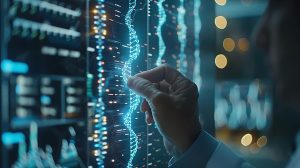Revolutionizing Data Storage: The Breakthrough in DNA Technology
Understanding DNA Data Storage and Computing
Traditionally, data storage and processing have been handled separately in conventional computing systems. However, this new technology integrates these functions into a single framework using DNA, which has been long considered a viable medium for long-term data storage. Project leader Albert Keung explains that while previous DNA technologies could perform some tasks, they lacked the ability to comprehensively manage data like electronic devices do.
Keung emphasizes, “In conventional computing technologies, we take for granted that the ways data are stored and the way data are processed are compatible with each other.” The challenge has been to create a system where data can be stored, retrieved, and computed efficiently using nucleic acids.
The Breakthrough: Dendricolloids
The key to this advancement lies in a new type of polymer structure known as dendricolloids. These structures are designed to maximize surface area while maintaining data density. Orlin Velev, a co-author of the study, describes dendricolloids as branching polymers that create a network of nanoscale fibers, allowing DNA to be deposited without compromising its integrity.
“You could put a thousand laptops’ worth of data into DNA-based storage that’s the same size as a pencil eraser,” Keung states, illustrating the incredible data density achievable with this technology.

Innovative Functions and Practical Applications
This new DNA technology offers a range of functionalities similar to electronic devices. For instance, researchers can now copy DNA information directly from the surface of the dendricolloid material without damaging the DNA. They can also erase specific pieces of DNA and rewrite them, akin to editing files on a computer hard drive.
Kevin Lin, the first author of the study, highlights the significance of this capability: “It essentially allows us to conduct the full range of DNA data storage and computing functions.” This flexibility opens up numerous possibilities for applications in data management and molecular computing.
Collaborative Efforts and Future Prospects
The success of this project is attributed to collaborative efforts among various research teams. The integration of microfluidic channels has enabled the precise flow of nucleic acids and reagents, facilitating data movement and computing commands. Additionally, advancements in nanopore sequencing have improved the direct reading of data from RNA after copying it from DNA.
Looking ahead, the implications of this technology are vast. It could redefine how we approach data storage, making it more efficient and sustainable. The potential for DNA to secure data for millennia presents a compelling case for its use in future computing systems.
Conclusion
The breakthrough in DNA-based data storage and computing is not just a technological marvel; it represents a paradigm shift in how we think about data management. As researchers continue to explore the capabilities of DNA, we may soon see a future where molecular computing becomes a cornerstone of our digital landscape.

